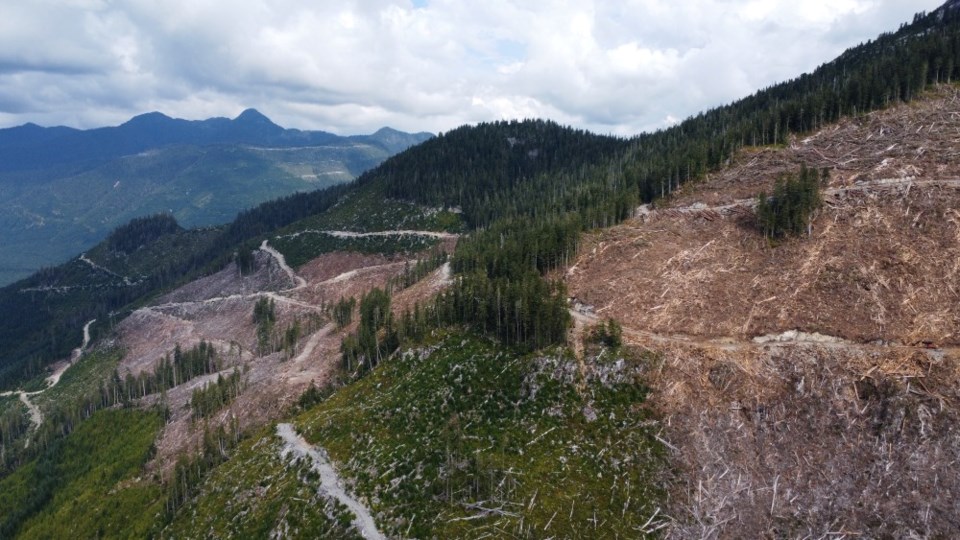A new study shows that over 55,000 hectares of proposed old-growth deferrals are at risk of being logged with some deferrals having already been destroyed or in the process of being clearcut in order to make way for pipelines.
Stand.earth released a report Tuesday that shows, via satellite imagery, the extent to which old-growth forests are being impacted.
“It's certainly discouraging, especially to see new roads being built into these areas. It really shows a failure on the part of the province to act and prevent, you know, that kind of threat being made to these areas,” Tegan Hansen, forest campaigner at Stand.earth, told Glacier Media.
The Union of British Columbia Indian Chiefs and Stand.earth are now renewing their calls on the provincial government to act immediately to stop logging in the most at-risk old-growth forests, they said in a statement.
In November 2021, the B.C. government identified 2.6 million hectares of old-growth forest across the province that needed to be immediately set aside from logging. This is done through the process of deferrals where logging is temporarily suspended for a period of time in an at-risk area. These deferrals are the result of the recommendations from the old-growth strategic review that was presented in April 2020. According to Stand.earth, not a single one of the 14 recommendations has been fulfilled since 2020.
“Last year when the heat dome was at its worst, the province assured my nation that there would be no activity in our forests. But when our community members witnessed loaded logging trucks coming down Spuzzum Main, we were told compliance was voluntary,” says Chief James Hobart, Spuzzum First Nation, in a statement. “It’s clear that the provincial government places too much trust in these companies. With a leadership race underway, it begs the question: will the next premier deliver on old-growth promises or stand by and let industry have its way?”
According to a statement from Minister of Forests Katrine Conroy, a number of First Nation groups have indicated that they do not support the deferrals proposed by the province. The statement also said that the ministry has always been clear that they will respect their decisions and will not be imposing deferrals unilaterally. Logging will proceed on their territories, Conroy said.
The report, titled "Tall Talk," says 1,600 hectares of candidate old-growth deferrals in four sample areas have already been logged by the forestry industry between March 2021 and March 2022, 43% of which was harvested after the government’s November announcement.
However, Conroy says that Stand.earth's report misses the forest for the trees.
“This report misleads the public by claiming that a “significant amount” of old growth has been logged. The Ministry of Forests has been monitoring the situation on the ground and — in fact — only around 0.3% of the proposed deferral areas have been harvested since November 2021 when engagements with First Nations started," Conroy said.
According to the minister's statement, around 80% of the most at-risk old-growth forests mapped by the independent Technical Advisory Panel are not threatened by logging because they are permanently protected, covered by recent deferrals, or uneconomic to harvest. That's an area equivalent to over 7,600 Stanley Parks, Conroy said.
Results of the report show that major industrial forest companies are the biggest threat to old-growth deferrals with Canfor at the top of the list. West Fraser is second followed by the Sinclar Group in third. Lastly, the fourth company posing a significant risk is TransCanada.
“What's the sense of having to implement a paradigm shift in forest management, and especially for management of old-growth forests, if in the process of creating that new paradigm, the industry is allowed to log all of the growth that they currently have permits for?” said Angeline Robertson with the Stand.earth Research Group.
Robertson said it's up to the electorate to push B.C.’s government to stay accountable when it comes to old-growth protection.
“The government has been really talking out of both sides of its mouth trying to say that it can implement these recommendations, but also really showing the industry that they have no teeth when it comes to getting them to stop logging,” she said.
According to Robertson, a May 2022 article from The Canadian Press shows the extent to which deferral areas have been logged.
“Seven thousand, two hundred hectares of growth deferrals had been cleared since the November 2021 announcement. And officially that number might be as high as 8,600 hectares now, which means they are tracking it,” she said, referring to the numbers obtained by reporter Brenna Owen.
Robertson believes the province should be clearer with the public and more transparent about where logging is taking place.



